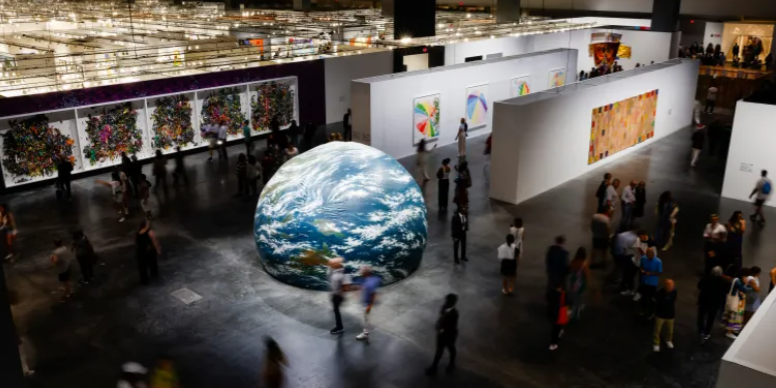After a challenging year, the annual industry report points to optimism and stability for 2024.
The art market faltered in 2023 amid factors like inflation and political instability, according to the newest findings from Art Basel and UBS, which reported a 4 percent dip in global art sales last year to an estimated $65 billion. This decrease comes after two years of sustained growth for the industry. “The focus for many in 2024 has shifted from rapid expansion at all costs to finding ways to achieve sustainable and profitable growth and stability as they continue navigating an uncertain economic and political future,” said economist Clare Mcandrew, author of the joint Art Basel and UBS report, in a statement.
Despite the downturn, Art Basel and UBS’s annual report still shows signs of hope. Sales remained above pre-pandemic levels and boomed in China, in addition to gaining momentum online; with both art dealers and auction businesses remaining largely optimistic about the coming year. Political and economic volatility, sustaining relationships with existing clients and the cost of participating in art fairs were cited as the three largest challenges faced by art dealers in 2023, who faced a 3 percent decline in sales in their sector to just under $36.1 billion. The auction world didn’t have a great year either—public auction sales measured at $25.1 billion, a 7 percent decrease from 2022.
Sales of works exceeding $10 million particularly suffered. While middle and lower-tier auctions—especially those priced under $50,000—experienced some growth, the $10 million-plus segment saw transactions decrease by 25 percent. However, this area continues to display the most growth over time, according to Art Basel and UBS, having grown to more than 2.5 times its size in 2009 when taking inflation into account.
Art market resiliency looks like optimism
Online sales also appear to be on an upward trajectory. With an increase of 7 percent in 2023, they now account for $11.8 billion, or 18 percent, of market turnover. “This underlines how this segment of the art business is maturing, with dealers’ websites being the preferred outlets for collectors to make their purchases,” said Noah Horowitz, CEO of Art Basel, in the report.
China, meanwhile, had a particularly strong year. While the U.S. still maintains its position as the leading global art market with 42 percent of sales by value, China surpassed the U.K. to take second place with a 19 percent share. It experienced a 9 percent increase in sales, up to an estimated $12.2 billion, which was largely boosted in early 2023 by the return of auctions and art fairs after COVID-19-related lockdowns eased.
China’s auction industry also shined, rising from the second largest market to equalize with the U.S., which both make up 31 percent of public sales. The country’s rebound boosted sales in the Old Masters segment, which saw a 15 percent increase in values to $1.1 billion.
Looking forward to 2024, Art Basel and UBS reported optimism among art dealers and auction businesses alike. Around 36 percent of dealers expect sales to improve, while 38 percent of auctioneers are hopeful that the next year will bring better business. Tapping into emerging trends in consumer spending could play a part in increased stability for the art world, according to the report, which pointed to the “Taylor Swift” effect of increased spending on leisure and in-person activities as opposed to physical goods.
“We are observing a shift in the luxury market away from goods purchases towards spending more on ‘having fun’—leisure travel, entertainment and socializing,” noted Paul Donovan, chief economist at UBS Global Wealth Management, in the report. “Art is so much more than possessing physical objects, and the events, experiences and social networks associated with collecting should provide support for the sector.“
